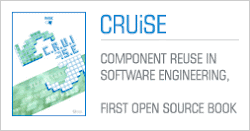
In 1996, Wayne Lim wrote a paper E
volution of the Software Reuse Business published in the
4th International Conference on Software Reuse (ICSR). In his paper, Wayne discussed the roots of software reuse regarding the business point of view.
Wayne presented the case of the
Raytheon and its efforts at the
Raytheon Missiles Systems Division dating back to the mid-1970’s. In that time, the company developed a system which included logic structures, an index system, a library, some design specifications and coding standards. Some years after (1981), Raytheon through the
Raytheon Computer Services created its reusable system
ReadyCode. Next, with this experience they created a company,
MasterSoftware, called the
world’s first fully reusable software company, as described by Wayne.
Nowadays, we do not have any news about this company even tough Raytheon is still on business. In Wayne’s analysis, the main issue was that their system was success
within Raytheon and the market outside the company boundaries is sometimes very different. Wayne highlights the importance of
marketing since reuse within a company differs from reuse as an external business. The second point is the
life cycle stage of the technology. In that time, reuse was a new way for the market and the need for
education and
culture was/is too important too.
From that time, we can see many companies on the road and some of them created by the main researchers on the field working in different areas. Examples of companies created from academic researchers include
Bayfront Technologies Inc, a company located in California, founded in 1992 by James Neighbors, one of the pioneers in domain analysis.
Semantic Designs, Inc, located in Austin, Texas, USA, was founded in 1995 by Dr. Ira Baxter and Dr. Christopher Pidgeon.
BigLever Software, Inc is also located in Austin, Texas, being founded in 1999 by Charles Krueger, an important expert in software reuse. Other important researchers also have their companies, such as Bill Frakes, with Software Engineering Guild, Ruben Prieto-Diaz, with Reuse, Inc, Ted Biggerstaff, with
www.softwaregenerators.com, and Wayne C. Lim, with the
Lombard Hill Group, all of them working with consulting and services related to software reuse.
Not directly associated to academic researchers, the
Flashline, Inc. company was a large metadata repository vendor, located in Cleveland, OH, USA. It was purchased in 2006 by
BEA Systems, Inc, which incorporated Flashline's repository into its product family. Examples of reuse-dedicated companies from other countries include
The Reuse Company, located in Madrid, Spain, with tools for knowledge reuse, and
Pure-Systems, founded in 2001 in Germany.
In Brazil,
RiSE is also a company offering software reuse solutions based on the
C.E.S.A.R and RiSE expertise on the topic.
All of these efforts show that the market is looking for ways to increase the productivity, quality and reduce costs and software reuse is an effective way to achieve it. However, in order to be successful it involves a
mix of different and important ingredients.
 In the last year, we created RiSS - RiSE Summer School on Software Reuse. The main goal of RiSS is to discuss the main software reuse issues with the main experts in the field from industry and university. In this year, we had the second edition and I believe that the summer school was very nice. In the program, a full discussion about software product lines, the main topic on the software reuse area. As lecturers, we had experts from industry and university from several countries around the world. This mix is part of the RiSS successful.
In the last year, we created RiSS - RiSE Summer School on Software Reuse. The main goal of RiSS is to discuss the main software reuse issues with the main experts in the field from industry and university. In this year, we had the second edition and I believe that the summer school was very nice. In the program, a full discussion about software product lines, the main topic on the software reuse area. As lecturers, we had experts from industry and university from several countries around the world. This mix is part of the RiSS successful. In this year, we had the award again for the best lecture and Paul Clements joined to Wayne Lim with the best presentation about product line architecture.
In this year, we had the award again for the best lecture and Paul Clements joined to Wayne Lim with the best presentation about product line architecture.







